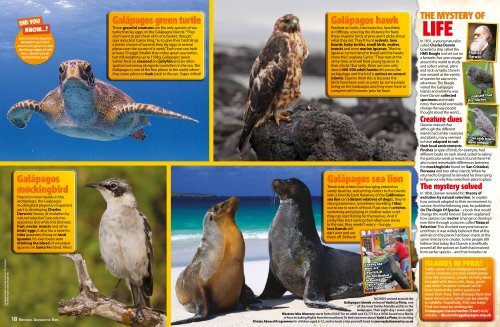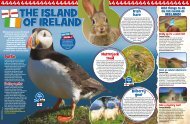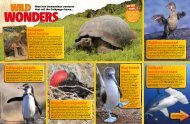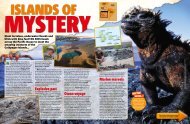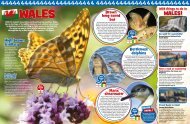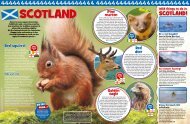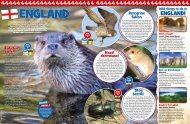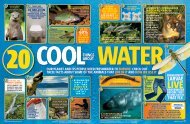109 NGK0315galapagos5-6.v12
- No tags were found...
You also want an ePaper? Increase the reach of your titles
YUMPU automatically turns print PDFs into web optimized ePapers that Google loves.
DID YOU<br />
KNOW...?<br />
Just as marine iguanas<br />
sneeze to get rid of<br />
excess salt, green turtles<br />
shed large tears of salt<br />
from special glands<br />
behind their eyes!<br />
Galápagos<br />
mockingbird<br />
Found on most islands in the<br />
archipelago, the Galápagos<br />
mockingbird played an important<br />
part in developing Charles<br />
Darwin’s ‘theory of evolution by<br />
natural selection’ (see column,<br />
opposite). But while this bird eats<br />
fruit, nectar, insects and other<br />
birds’ eggs, it also has a taste for<br />
ticks (parasites) living on land<br />
iguanas. It’s even been seen<br />
drinking the blood of wounded<br />
iguanas on Santa Fe island. Yikes!<br />
Galápagos green turtle<br />
These graceful creatures are the only species of sea<br />
turtle that lay eggs on the Galápagos Islands. “They<br />
don’t want to put them all in one basket, though,”<br />
says naturalist Carlos King, “so to give their hatchlings<br />
a better chance of survival they lay eggs in several<br />
places over the course of a week.” Each nest can hold<br />
at least 70 eggs! Smaller than other green sea turtles,<br />
but still weighing up to 150kg, Galápagos’ green<br />
turtles feed on seaweed and jellyfish and are often<br />
spotted swimming alongside snorkellers in the sea. The<br />
Galápagos is one of the few places in the world where<br />
they come ashore to bask (rest) in the sun. Super chilled!<br />
Galápagos hawk<br />
Perched on rocks, tree branches, lava fields<br />
or clifftops, scouring the distance for food,<br />
these majestic birds of prey aren’t picky about<br />
what they eat. They’ll hunt rodents, lava<br />
lizards, baby turtles, small birds, snakes,<br />
insects and even marine iguanas. “Marine<br />
iguanas come inland to breed and the hawks<br />
know this,” explains Carlos. “They nest at the<br />
same time, and will feed young iguanas to<br />
their chicks.” But sadly, there are now only<br />
about 400-500 adult hawks left across the<br />
archipelago and the bird is extinct on several<br />
islands. Experts think this is because the<br />
birds have been seen as pests by some people<br />
living on the Galápagos and they even have to<br />
compete with humans’ pets for food.<br />
Galápagos sea lion<br />
These cute critters love lounging around on<br />
sandy beaches, welcoming visitors to the islands<br />
with a friendly bark! Relatives of the Californian<br />
sea lion (and distant relatives of dogs!), they’re<br />
strong swimmers, sometimes travelling 15km<br />
out to sea in search of food. Pups stay in crèches,<br />
swimming and playing in shallow water until<br />
they can start fishing for themselves. And if<br />
pesky flies start ruining their afternoon siesta<br />
in the sun, they needn’t worry – hungry<br />
lava lizards will<br />
dart over and eat<br />
them off. Brilliant!<br />
THE MYSTERY OF<br />
LIFE<br />
In 1831, a young naturalist<br />
called Charles Darwin<br />
boarded a ship called the<br />
HMS Beagle and set out on<br />
a fantastic five-year voyage<br />
around the world to study<br />
and collect animal, plant<br />
and rock samples. Darwin<br />
was amazed at the variety<br />
of species he saw on his<br />
adventure. The Beagle<br />
visited the Galápagos<br />
Islands and while he was<br />
there Darwin collected<br />
specimens and made<br />
notes that would eventually<br />
change the way people<br />
thought about the world...<br />
Creature clues<br />
Darwin noticed that<br />
although the different<br />
islands had similar creatures<br />
and plants, many seemed<br />
to have adapted to suit<br />
their local environments.<br />
Charles<br />
Darwin…<br />
… noticed that<br />
the finches...<br />
… on each island<br />
were unique!<br />
Finches (a type of bird), for example, had<br />
different beaks on each island, suited to eating<br />
the particular seeds or insects found there! He<br />
also noted remarkable differences between<br />
the mockingbirds found on San Cristobal,<br />
Floreana and two other islands. When he<br />
returned to England he devoted his time trying<br />
to figure out why they varied from place to place.<br />
The mystery solved<br />
In 1858, Darwin revealed his ‘theory of<br />
evolution by natural selection’, to explain<br />
how animals adapted to their environment to<br />
survive. And the following year, he published<br />
On The Origin Of Species – a book that would<br />
change the world forever! Darwin explained<br />
how species can ‘evolve’ (change or develop)<br />
over time through a process called ‘Natural<br />
Selection’. This shocked everyone because,<br />
until then, it was widely believed that all the<br />
animals on the planet had been made at the<br />
same time by one creator. Some people still<br />
believe that today. But Darwin scientifically<br />
proved all the species on Earth had evolved<br />
from earlier species – and that includes us!<br />
Galápagos hawk and fish market © Tim Herbert.<br />
All other images: Getty Images UK.<br />
18 National Geographic Kids<br />
Cheeky sea<br />
lions are<br />
regulars at<br />
the fish market<br />
in Puerto<br />
Ayora, Santa<br />
Cruz island!<br />
NG KIDS cruised around the<br />
Galápagos Islands on board Yacht La Pinta, one<br />
of the most family-friendly yachts in the<br />
Galápagos. Their eight-day / seven-night<br />
Western Isles Itinerary starts from £5,047 for an adult and £3,775 for a child, based on a family<br />
of four including flights from the mainland. To find out more about Yacht La Pinta, its exciting<br />
Pirates Aboard Programme for children aged 6-12, and to book a trip yourself, head to journeylatinamerica.co.uk<br />
ISLANDS IN PERIL!<br />
Sadly, many of the Galápagos islands’<br />
native creatures are now endangered.<br />
Over the centuries, people moving there<br />
brought with them cats, dogs, goats<br />
and other ‘invasive’ animals which<br />
have hunted the native species or<br />
eaten their food. New diseases have also<br />
been introduced, which can be deadly<br />
to wildlife. Thankfully, YOU can help!<br />
Find out more by visiting the<br />
Galapagos Conservation Trust’s kids’<br />
website – discoveringgalapagos.org.uk


